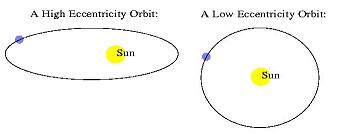
Home
Rocketry
Orbits
Gravity
Kepler's Laws
Orbital Elements
Types of Orbits
Orbit Transfers
Going to the Moon
Technology
Orbital Elements
Just like how we use mile markers to describe our position on a highway, or how we use street intersections to describe our position in a city, there must be a method of describing the position of a satellite in orbit. The following six orbital elements are used to describe a rocketís position in space.
- Inclination
- "i" is a measure of how much angular difference there is between the earth's equator and the orbiting satellite.
- Semi-Major Axis
- "a" is a measure for the size of the ellipse. It is measured from the center to the edge of the ellipse.
- Eccentricity
- "e" is a measure of how circular (or non-circular) the orbit is.
- Longitude of Ascending Node
- The line of nodes defines the intersection between the ecliptic plane and the orbital plane, which are inclined by "i". The longitude of the ascending node "Ω" describes the point where the orbital path becomes higher then the equator, passing from south to north.
- Argument of Periapse
- "Ω" describes the position which the orbit reaches its maximum radius.
- True Anomaly
- describes the position of the satellite along its orbit.


